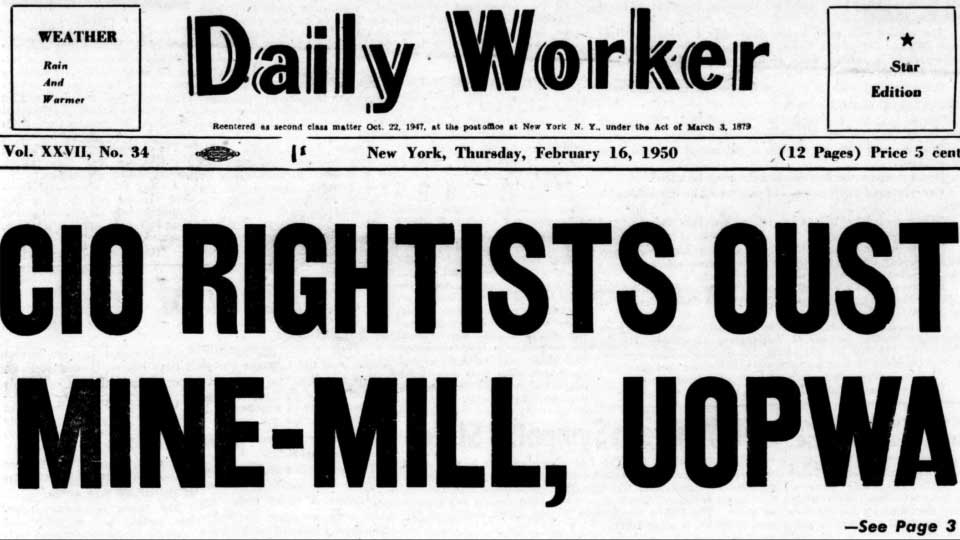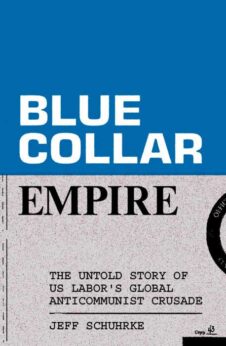
Jeff Schuhrke’s Blue Collar Empire reveals a tragic irony of modern labor history: the very anti-communism that was allegedly meant to “protect” workers became a weapon used to divide and weaken them internationally. This isn’t just a story about the Cold War—it’s about how attacking the broad left, specifically the communists, in the labor movement left all workers more vulnerable to the big business attacks, then and now.

The damage began on the international stage. After World War II, when unions internationally united in the World Federation of Trade Unions (WFTU) to fight for worker solidarity, democracy, and peace, the U.S. government and its corporate backers saw this internationalism as a real threat to their profits.
The American Federation of Labor (AFL), before and after their merge with the Congress of Industrial Organizations (CIO) in 1955, became a key partner in dismantling this unity, helping split the WFTU to create a rival anti-communist federation, the International Confederation of Free Trade Unions (ICFTU), that more closely aligned with imperialist foreign policy rather than workers internationally.
This wasn’t just about ideology, though—it had concrete consequences. In country after country, from France to Chile to Indonesia, the breaking of militant and left unions meant weaker labor movements that couldn’t resist neoliberal privatization, wage cuts, or even violent right-wing dictatorships. It undermined the labor principle of “an injury to one is an injury to all” and led to a race to the bottom for workers everywhere.
At home, the same anti-communist state repression, including thousands jailed and thousands more expelled, that repressed international solidarity also gutted the U.S. labor movement’s fighting spirit on the whole. The purging of left-led unions like the United Electrical Workers, International Longshore and Warehouse Union, plus nine other trade unions, along with communist and socialist elements in union leadership, removed some of labor’s most effective organizers and undermined militant tactics.
The United Auto Workers (UAW) president at the time, Walter Reuther, best exemplified the “free” trade union movement ideology—class collaboration at the expense of class struggle. As Schuhrke said: “Instead of a constant struggle for control of the workplace through strikes, slowdowns, and similar militant tactics, Reuther held that unionized workers would gain far more by behaving themselves on the shop floor and boosting production in exchange for getting to partner with government and industry in economic planning.”
Abroad, the “free” trade union federation was complicit in, or even supported, right-wing coups that killed workers in the name of anti-communism. They actively undermined, for instance, communist-led unions in Indonesia, China, and Vietnam. At home, anti-communist red-baiting purges removed labor’s most militant voices, communist or not, leaving unions ill-equipped to resist Reagan’s union-busting.
As Schuhrke documents, this made it easier for big capital to crush strikes in the 1980s and up through today with the Trump administration’s assault on the labor movement. But Schuhrke argues the labor movement’s decline wasn’t inevitable—it was the result of choices to prioritize anti-communism over worker power.
By the 1980s, as Reagan crushed the PATCO strike and corporations expanded their massive plant closures, layoffs, and offshoring schemes, the AFL-CIO’s leadership had spent decades siding with State Department interests, leaving workers weakened at home. Union membership plummeted, and the labor movement never recovered.
The harmful anti-communist legacy of the Red Scare period continued via financing the AFL-CIO’s Solidarity Center through groups like the now-defunded U.S. Agency for International Development (USAID) and the National Endowment for Democracy (NED).
Rather than building genuine worker solidarity, these organizations pushed U.S. imperialism’s policy objectives, often at the expense of workers everywhere. For example, they undermined independent unions in places like Mexico while doing nothing to stop the exploitation of migrant workers here at home.
Ultimately, the practice of foreign meddling ended up hurting U.S. workers by diverting union resources that could have been used for domestic organizing to U.S. imperialism’s foreign policy objectives, including destabilization efforts of countries and their labor movements that sought an independent path of development.
This international race to the bottom served monopoly capitalism perfectly. For instance, when Mexican maquiladora workers were prevented from independent organizing, it pressured U.S. autoworkers to accept lower wages. When Latin American, African, or Asian unions are destabilized, it threatens all workers’ standards.
Schuhrke’s book ultimately poses a crucial question: Will the U.S. labor movement move past its dark past of anti-communism and usefulness as a tool of imperialism? And will it rediscover its power as a united, militant movement that speaks for the whole of the working class?
For any trade union activist interested in a deeper understanding of our labor movement’s history and the internal struggles and contradictions within it, Schuhrke’s book is an essential resource.
Blue-Collar Empire: The Untold Story of US Labor’s Global Anticommunist Crusade
By Jeff Schuhrke
Verso Books
September 2024 / 9781839769054
$29.95 paperback.










